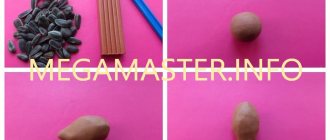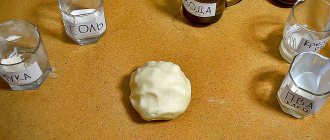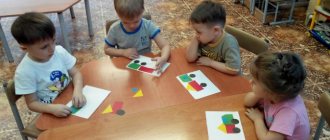Notes on sculpting "Kitten" lesson plan (senior group)
SUMMARY OF NODS
on productive activities (modeling) for children of the older group
Theme: "Kitten"
Tasks:
Educational:
Create an image of an animal in sculpting; convey the pose of a kitten in sculpting.
Strengthen the ability to sculpt an animal figurine in parts, using different techniques: rolling clay between the palms, pulling out small parts, connecting parts by pressing and smoothing the joints.
Educational:
Develop fine motor skills of children's hands.
Educational:
Cultivate a love for pets.
Integration of OO: artistic and aesthetic development, cognitive.
Progress of the lesson: Children sit on chairs placed in a semicircle. The teacher comes in with a basket. Guys, today one pet came to visit us. But it is very sad, because he has no friends. And in order to find out who is sitting there, we need to solve several riddles.
What kind of animal is playing with me? Doesn't moo, doesn't neigh, doesn't bark, attacks balls, hides claws in its paws.
Mustachioed muzzle Striped fur coat Washes often But doesn’t know how to handle water.
He cries at the threshold, hides his claws, quietly enters the room, purrs and sings. That's right, guys - it's a kitten.
Do you agree to help him (children's answers). Let us make friends for our kitten from plasticine. And in order to make friends for him, we must pass several tests. 1. Does anyone know a poem about a cat? (reading a poem by Natalya). 2.The second task is called “What’s missing?” (finish the kitten) 3. Third task - “Fold a kitten from geometric shapes” (children take turns folding a kitten from geometric shapes).
Physical education minute:
The window opened (arms to the sides) The cat came out onto the ledge (cat’s smooth gait)
The cat looked up (the head was thrown up)
The cat looked down
I looked to the left
I watched the flies
Stretched and smiled
And she sat down on the ledge.
So we got to our modeling table. We have already sculpted a horse. Let's remember where to start sculpting (knead the plasticine and divide it into parts). What shape is a kitten's body? Head? Tail? (oval, elongated head, long tail). We will sculpt from a whole piece of plasticine. Tamara, tell us how we will sculpt (we need to roll out a thick sausage, cut it into a stack on both sides - these are the legs. Then we roll out the ball - stretch out the muzzle and ears. We attach the muzzle to the body and smear it well. The tail should be thin and long). Guys, to warm up our hands before work, we will do some finger exercises.
Cunning, little Kitten (ball squeezed between palms) Just got out of diapers, (palms open) Did a lot of things: (palms close) Ate a fish from a raccoon, (circular movements between palms) Started a fight with a hamster, (Squeeze the ball in your right hand) Only the dog was scared. (squeeze in left hand) Ill-mannered child (circular movements on the table with one hand) This little Kitten. (circular movements on the table with the other hand) Let's start sculpting. Children sculpt, the teacher helps individually as needed. Well done guys, you all coped with the task. Now our cat is very happy, and thanks you all for new friends.
On the topic: methodological developments, presentations and notes
GCD in the senior modeling group.
An open lesson for senior group students and parents in the educational field “Artistic Creativity” (modeling from salt dough) on making a Kuban horseshoe amulet within the framework of realia.
A unique center of folk art, a typical phenomenon of folk culture, is the village of Khludnevo, Duminichsky district, Kaluga region. The Khludnev toy is evidence of undying folk traditions.
Goal: To consolidate the ability to sculpt a bird, choosing the sculpting method independently, to convey the shape and relative size of the body and head; help to remember the differences between birds of different breeds in color and plumage.
The use of this material helps to consolidate preschoolers’ knowledge about domestic animals, and also develops children’s ability to perform appliqué using cotton wool.
Source
Ginger cat
The sign says that a ginger cat brings good luck to the owner.
To make a figure from plasticine, prepare a place and the necessary tools:
- orange plasticine;
- additional colors - yellow, green - for eyes, brown, white or any other colors - for decorations;
- match;
- stack - a plastic knife for work.
Modeling a cat from plasticine consists of the following steps:
- Take a brick of orange material for the body. You will need 3 times less white plasticine; parts are made from it.
- Roll an oval out of the red-colored mass and pull the workpiece out on one side. You will get a long neck. We insert a match into it to secure the cat's face. We slightly bend the shape to get a figurine of a sitting animal. We attach a small white spot on the cat’s chest - it will be like a tie for the cat. Using a special knife, we make small grooves that imitate animal fur.
- We form 2 orange tablets for the bent hind legs and secure them on both sides of the body. At the bottom we attach small white plasticine pads.
- We twist 2 orange tubes for the cat's front legs. We expand them at the ends.
- We make the head in the shape of a flattened diamond. We make triangular ears from 2 miniature orange tablets.
- We attach the front legs to the cat's body. They should be about the same level. We make a tail and attach it to the body. We glue a white plasticine mustache, cheeks and a pink nose to the head.
- We attach the ears to the head. We cut strips on the mustache with a stack. To get slanted cat eyes, we stick green pupils to oval shapes made of white material. We fix the eyes on the muzzle.
- We connect the head to the body with a match.
More interesting: How to make a mouse from plasticine - step-by-step instructions for children
Surprised kitten
We sculpt a cat from plasticine, who is very surprised. His eyes are so big that you can immediately see: this kitten is very curious, and something amazes him. How to make a cat with such a range of emotions out of plasticine? Very fast!
Cats are charismatic, interesting animals with very expressive habits and features, which is why they are so interesting to sculpt. With every new cat made, our world becomes a little sweeter. Crafts have their own advantage. A plasticine cat may not purr, but it won’t scratch the furniture!
Source
Progress of the lesson:
Guys, you recently visited Yuri Kuklachev’s Cat Theater. Did you like performing cats ?
Children talk about their impressions.
— Do you want to make a cat and organize your own Cat Theater in our group?
- Then let's look at it. What shape is a cat's ?
- What kind of head does our cat ?
- What’s on the cat’s head ?
— Does our cat have a tail ? What is he like?
Long, oval, fluffy.
- How can you blind a cat ?
From pieces: from a ball - a head, from a cylinder - a torso, from small cylinders - legs and a tail.
- I’ll remind you of another sculpting that will help us sculpt cats and show how they move.
Divide the lump of clay in half - cut off in a stack; one half - for the body and paws; the other is for the head and tail. We make a cylinder from one part. Animals usually move on four legs, so the cylinder (roller)
you need to turn it like this
(the teacher turns the cylinder into a horizontal position)
. Then bend it in an arc and cut it at both ends with a stack to make four legs. This is a body with legs. All that remains is to sculpt the head and tail. Tell me how best to do this?
— You and I sculpt not just cats, but cats who are artists. Therefore, the body can be positioned as if the animal is standing on two legs, or on four. And the head can be attached to the body from above or to the side, on the neck or directly on the body.
— There are many artists in the Cat Theater. May you get different cats !
Children begin sculpting , independently choosing a pose for the sculpted cat .
At the end of the work, the teacher says:
- You made a cat , now let's see what your cat , what number it is showing us.
The teacher examines all the sculpted figures and notes the most expressive ones.
- Now let’s choose a place in the group for our Cat Theater so that it’s convenient to organize performances!
Nod move:
Educator: Guys, today one animal came to visit us. And in order to find out who is sitting there, we need to solve several riddles.
What kind of animal is playing with me?
Educator: That's right, guys - this is a cat . But she is very sad. Why do you think? How can we help her? Do you agree to help her (children's answers)
.
Let us make friends for our cat out of plasticine.
Educator: Let's remember where to start sculpting (knead the plasticine and divide it into parts)
.
— What shape is a cat’s ? Head? Tail? (oval, elongated head, long tail)
.
- We will sculpt from a whole piece of plasticine. You need to roll out a thick sausage, cut it into a stack on both sides - these are the legs. Then we roll out the ball - draw out the face and ears. We attach the muzzle to the body and lubricate it well. The tail should be thin and long.
Educator: Guys, to warm up our hands before work, we will do some finger exercises.
Cunning little Kitten (ball held between palms)
Just got out of diapers, (palms open)
Did a lot of things: (palms close)
Ate a fish from a raccoon (circular movements between palms)
I started a fight with a hamster, (Squeeze the ball in your right hand)
Only the dog was scared (squeeze in left hand)
Ill-mannered child (circular movements on the table with one hand)
.
This little Kitten (circular movements on the table with the other hand)
.
Educator: Let's start sculpting . (Children sculpt, the teacher helps individually as needed)
.
"These funny cats." Thematic notes for older age. Modeling lesson “Cats-artists”
Elena Meleshko
“These funny cats.”
Thematic notes for older age. Sculpting lesson “Cats-Artists” Sculpting lesson in the senior group “
Cats-Artists ” .
Goal: To teach children to create an animal image in modeling . Strengthen the ability to sculpt from a whole piece using clay cuts from the ends. Use different techniques in work: rolling clay between the palms, pulling small parts, connecting parts by pressing and smoothing the joints. Learn to convey the pose of a cat in sculpting .
Preliminary work: Conversation about pets. Examination of illustrations in books, albums (image of animals by Yu. Vasnetsov,
E. Charushin). Reading of the poem by V. Shipunova “What the Siberian cat dreams of”
. Visit with parents to the Yu. Kuklachev Cat Theater. Looking at a toy cat.
Material: Clay, board, stack, cloth napkin (wet)
for each child, a
cat .
Modeling a cat for the little ones
The first principle of sculpting will be similar to sculpting dogs, which we talked about in the previous article. This modeling from plasticine for children 3-4 years old is especially relevant, since the process is simple, interesting and, of course, useful. Due to the fact that the figurine is miniature and the material itself is plastic, children will develop fine motor skills and activate their imagination.
In order for your child to learn how to make such a figurine, be sure to participate with him in the creative process. If your child is still very young, try to choose the softest plasticine for work, which does not need to be prepared for work by warming up and warming up.
Before molding a cat from plasticine, prepare:
- plasticine (the baby can choose any color, since the finished kitten does not have to be natural, perhaps it will be fabulous);
- plastic knife for working with material;
- a board or other substrate to protect the table from plasticine.
Let's get started:
- The first thing you need to do is sculpt the cat’s body. Roll out a sausage from the chosen color. This will become the basis of the cat.
- When the base is ready, you can start making the paws. Roll out four small balls and shape them into an oval. Using the same pattern, we make a tail for the future cat. It should resemble a sausage with a curved end.
- When the previous parts are ready, start making the head. Roll a large ball and give it a slightly flattened appearance. This is the future face.
- At the top of the flattened ball you need to form ears. Find the middle and gently press with your finger to create an indentation. We give the protruding sides a triangular shape.
- Let's decorate the cat with a bib. Roll out the ball and give it the appearance of a “coin” and attach it to the cat.
We connect all the received elements. Attach the paws and tail to the body, hide the joints by carefully smoothing the plasticine. Our cat is almost ready, and instructions on how to make a simple cat out of plasticine continue. A craft cannot be considered complete if it does not have a pretty face with a certain expression. It remains to add a few details.
Let's start making the muzzle:
- make the eyes (use white as a base and green or blue for the pupils);
- a pink ball is suitable for the nose;
- We will make the cheeks and mouth from gray peas.
Attach all the small parts to the muzzle. The cat is ready. You learned how to make a cat out of plasticine for small children. The cat will not necessarily stand; your baby can give it a sitting or lying appearance.








